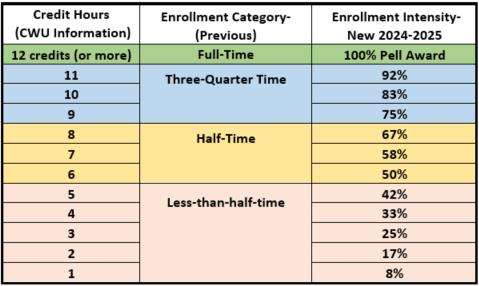Types of Financial Aid
 Get printer-friendly version of this page
Get printer-friendly version of this page
Students who apply for financial aid are considered for all aid programs for which they are eligible. The most common types of financial aid are listed below:
Grants
Grants are awarded to undergraduate students who have not earned their first bachelor’s degree. Grants prorate for students enrolled in less than full-time in a term. Eligibility is determined using the information reported in the FAFSA and reviewed by the Financial Aid Office.
Federal Pell Grant
Federal Pell Grants are awarded to undergraduate students who have not earned their first bachelor’s degree and have not reached the Pell Grant Lifetime Eligibility limit. Pell eligibility is determined by a formula developed by the U.S. Congress and is applied consistently to all applicants using the information reported in the FAFSA.
SAI, or Student Aid Index, is replacing the term Expected Family Contribution, know as EFC. The SAI brings a change in the methodology used to determine aid. The SAI is a number used to determine eligibility for need-based aid. It is calculated using information provided by the student (and contributors, if required) on the FAFSA form. The SAI will replace the Expected Family Contribution (EFC) starting in the 2024-25 award year. A student's SAI can be negative number down to -1,500 (negative 1,500).
Your aid eligibility is based on the following formula:
Cost of Attendance (COA) – Student Aid Index (SAI) – Other Financial Assistance (OFA) = Need.
Main Differences between SAI and EFC
Child support received will now count as an asset instead of income and family farms/small businesses will now also count as assets. The number of family members in college is no longer considered in the needs analysis formula, but it is still a required question on the FAFSA® form.
Additional information on the SAI formulas can be found in the 2024-25 DRAFT Pell Eligibility and SAI Guide.
Pell Grant Eligibility Determination
Students may qualify for a maximum Pell Grant based on family size, adjusted gross income, poverty guidelines, and tax filing status. Students qualifying for a maximum Pell Grant will have a Student Aid Index (SAI) between –1500 and 0. For students who don't qualify for a maximum Pell Grant may still be eligible if their calculated SAI is less than the maximum Pell Grant award for the award year. The studdent's Pell Grant award will be equal to the maximum Pell Grant for the award year minus their SAI. For Students whose SAI is greater than the maximum Pell Grant award for the year may still be eligible for a Pell Grant based on family size, adjusted gross income, and poverty guidelines.
Pell Grant Minimum/Maximum Determining Factors:
-
- AGI (if required to file a federal tax return)
- Household Size and number of parents
- Federal poverty guidelines
Non-tax filers
According to the IRS tax year 2022, these are the thresholds by filing status. If parents of a dependent student or an independent student (and spouse, if married) were not required to file a federal income tax return for 2022, the student will automatically receive a Student Aid Index (SAI) equal to –1500.
Negative SAI
Students with a negative or 0 SAI will be eligible for the maximum Pell Grant. The difference is that the negative -1500 SAI indicates the student has a higher need than the student with 0 SAI, being eligible for other grants, if available, like Federal Supplemental Educational Opportunity Grant (FSEOG) or institutional need-based grants.
Family Size Adjustments
If family size is manually adjusted while completing the FAFSA the SAI will be based on the family size that the family entered, if different from the taxes. Students may have to provide additional information to verify the household size if selected for verification.
Enrollment Requirements
Beginning with the 2024-2025 aid year, the Pell Grant will no longer be based on enrollment status. Instead, Pell Grant disbursement amounts will now be calculated using Enrollment Intensity - which is a percentage value based on the number of credits a student is enrolled for during a term. For federal student aid purposes, full-time enrollment is 12 credit hours. The chart below illustrates enrollment intensity relative to full-time enrollment
Please note that enrollment cannot exceed 100% for purposes of Pell Grant proration.

Federal Supplemental Education Opportunity Grant (FSEOG)
This grant is awarded to undergraduate students who have not earned their first bachelor’s degree and have financial need. Priority is given to students who receive Pell Grants and have high financial need (i.e. the lowest Expected Family Contribution or “EFC”) as determined by a formula developed by the U.S. Congress and is applied consistently to all applicants using the information reported in the FAFSA.
State & Institutional Grants
To qualify for one of the state or institutional grants, a student must be a Montana resident, be eligible for financial aid, and be an undergraduate who has not earned their first bachelor’s degree. Enrollment in at least six credits is required for most state grants. Eligibility for these funds are determined by using the information reported in the FAFSA.
Work-Study and Student Employment
Federal and State Work-Study Programs
The federal and state work-study programs provide students with part-time employment both on-campus and off-campus (off-campus work-study jobs are limited to community service employment). Students can request to be considered for work-study by answering ‘yes’ to the “Interested in Work-Study” question on the FAFSA. Eligibility is determined using the information reported in the FAFSA. For more information visit our Workstudy page.
Student Employment
The Job Locator and Developer (JLD) assists MSU Billings students in obtaining part-time employment in the community. Area businesses list job opportunities with the Job Locator. The Job Locator Service is free to all MSU Billings students and is not based on financial need. Students who are interested in obtaining employment should refer to the Career Link for available job listings.
Loans
Loans are a major source of financial aid for students. Student loans must be repaid after the student graduates, withdraws from school, or drops below six-credits in a semester. Interest rates, grace periods, and repayment requirements vary depending on the type of loan. For more information visit our Loans page.
MSUB Scholarships
MSU Billings awards $1.5 million in scholarships each year. To be considered for all MSUB scholarships students must complete the General Scholarship Application online. Priority is given to those who apply by February 1st of each year for the upcoming fall semester, however late applications are encouraged as awarding occurs all year long.
Tuition Waivers
MSU Billings has tuition waivers for veterans, American Indians, faculty and staff (and their dependents), advanced honor students, athletes, graduate students, war orphans, dependents of firemen and policemen killed in the line of duty, and students with certain majors. Eligibility and selection criteria vary. Certain waivers require a separate application form and in some cases additional documentation in order to qualify. To be eligible for Department waivers students must complete the General Scholarship Application by the February 1st priority date. Inquire at the Office of Financial Aid and Scholarships for specific information regarding tuition waivers. For more information visit the Montana University System website.
Other Programs Available
Outside Scholarships
The MSU Billings Office of Financial Aid & Scholarships provides additional links and helpful tips for finding and applying for scholarships on our Scholarships website.
State Vocational Rehabilitation Service
Students with disabilities may qualify for educational assistance through the Montana Department of Social and Rehabilitation Service. Contact your local office for more information.
Tribal Higher Education Funding
Tribal Higher Education Funding is available for many American Indian students. Each Tribe determines eligibility based on its criteria and standards. Students should contact their Tribal Higher Education office for more information. Tribes require the MSUB Office of Financial Aid and Scholarships to complete a needs analysis form. We recommend that students submit this form to the MSUB Office of Financial Aid and Scholarships at least two weeks prior to the tribal deadline.
Veterans’ Benefits
Students may apply for veterans’ educational benefits through the Veterans Administration. For more information, students should contact the MSUB Office of Admissions and Records or their local Veterans Administration office. For more information on additional services offered for veterans visit our Veterans webpage.
